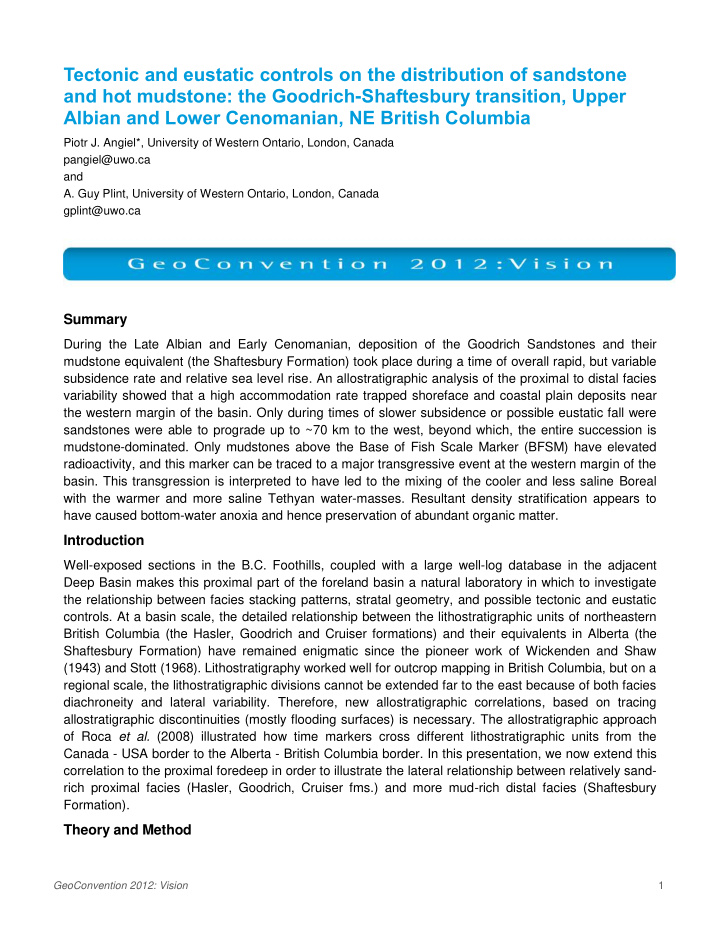



Tectonic and eustatic controls on the distribution of sandstone and hot mudstone: the Goodrich - Shaftesbury transition, Upper Albian and Lower Cenomanian, NE British Columbia Piotr J. Angiel*, University of Western Ontario, London, Canada pangiel@uwo.ca and A. Guy Plint, University of Western Ontario, London, Canada gplint@uwo.ca Summary During the Late Albian and Early Cenomanian, deposition of the Goodrich Sandstones and their mudstone equivalent (the Shaftesbury Formation) took place during a time of overall rapid, but variable subsidence rate and relative sea level rise. An allostratigraphic analysis of the proximal to distal facies variability showed that a high accommodation rate trapped shoreface and coastal plain deposits near the western margin of the basin. Only during times of slower subsidence or possible eustatic fall were sandstones were able to prograde up to ~70 km to the west, beyond which, the entire succession is mudstone-dominated. Only mudstones above the Base of Fish Scale Marker (BFSM) have elevated radioactivity, and this marker can be traced to a major transgressive event at the western margin of the basin. This transgression is interpreted to have led to the mixing of the cooler and less saline Boreal with the warmer and more saline Tethyan water-masses. Resultant density stratification appears to have caused bottom-water anoxia and hence preservation of abundant organic matter. Introduction Well-exposed sections in the B.C. Foothills, coupled with a large well-log database in the adjacent Deep Basin makes this proximal part of the foreland basin a natural laboratory in which to investigate the relationship between facies stacking patterns, stratal geometry, and possible tectonic and eustatic controls. At a basin scale, the detailed relationship between the lithostratigraphic units of northeastern British Columbia (the Hasler, Goodrich and Cruiser formations) and their equivalents in Alberta (the Shaftesbury Formation) have remained enigmatic since the pioneer work of Wickenden and Shaw (1943) and Stott (1968). Lithostratigraphy worked well for outcrop mapping in British Columbia, but on a regional scale, the lithostratigraphic divisions cannot be extended far to the east because of both facies diachroneity and lateral variability. Therefore, new allostratigraphic correlations, based on tracing allostratigraphic discontinuities (mostly flooding surfaces) is necessary. The allostratigraphic approach of Roca et al. (2008) illustrated how time markers cross different lithostratigraphic units from the Canada - USA border to the Alberta - British Columbia border. In this presentation, we now extend this correlation to the proximal foredeep in order to illustrate the lateral relationship between relatively sand- rich proximal facies (Hasler, Goodrich, Cruiser fms.) and more mud-rich distal facies (Shaftesbury Formation). Theory and Method GeoConvention 2012: Vision 1
The rocks in the studied interval are characterized by strongly cyclical, sandier-upward transgressive- regressive successions, typically 5-20 m thick. The flooding surfaces that bound these successions are readily traceable in subsurface, sometimes for > 400 km, and can be considered to approximate time lines. This proxy chronostratigraphy provides a basis for facies and paleogeographic mapping. Isopach maps constructed for allostratigraphic units (effectively time slice maps of subsidence) allowed reconstruction of the subsidence history in three dimensions, on small time-steps. Paleogeographic maps for each time slices makes it possible to trace, with high resolution, changes in facies distributions in response to subsidence and eustasy. For this study gamma ray and/or resistivity logs from 435 wells were used to construct a grid of 20 cross sections with a spacing of ~20 km. These wells formed the basis for an allostratigraphic correlation grid over an area of about 50,000 km 2 . Twenty one outcrop sections totaling 4090 m have been investigated. Effort was made to correlate well logs with nearby outcrop sections in order to establish the nature of facies and bounding surfaces that were defined and mapped in subsurface. Results Overall geometry Allomembers show no clinoforms geometry, nor do they lap out onto a single discrete surface. Instead, each allomember fines and gradually thins eastward away from the orogen-proximal part of the foredeep. The sedimentological and stratigraphic evidence indicates that the proximal foredeep was a shallow, low-gradient, storm-dominated ramp. Sand was transported, primarily by combined flows, for up to 70 km offshore. The more distal part of the ramp accumulated mud. There is no evidence for the development of deep water (i.e. > ~30-40 m), and therefore the accommodation:supply ratio appears to have been near balance throughout deposition of the succession. Sandstone – mudstone transition Sandstone bodies comprising the Goodrich Formation were deposited in the most proximal foredeep, over about 1 My. Within the formation, eight major sandstone tongues, capped by flooding surfaces, can be recognized. Sandstones are stacked vertically in the west, where about 450 m of nearshore and coastal plain deposits are observed. An aggradational stacking pattern and a pronounced wedge- shaped geometry suggest that these units were deposited at a time of rapid subsidence and relative sea level rise. Lateral facies change is dramatic, and the progradional limit of inner-shelf sandstone (rippled heterolithic facies) never extends more than ~60-70 seaward of the paleoshoreline. It is interpreted that each progradational sandstone tongue was deposited during a phase of slower relative sea level rise, perhaps linked to periods of eustatic fall. It is remarkable that the Goodrich Sandstones vanish in about 70 km from the paleoshoreline, beyond which, the entire succession is represented by about 200 m of mudstone (the Shaftesbury Formation). The Base of Fish Scales Marker and the origin of hot mudstones The Base of Fish Scale Marker (BFSM) has a very prominent ‘hot’ signature in gamma ray logs, and is a basin-wide log marker. Towards the northwest, in British Columbia, the radioactive signature of the BFSM gradually fades. A chert-pebble veneered erosion surface underlies the BFSM and represents the most prominent sea level fall in the Goodrich time interval. The distribution of pebbles indicates that relative sea level fall caused the shoreline to move at least 130 km to the east. The overlying GeoConvention 2012: Vision 2
Recommend
More recommend